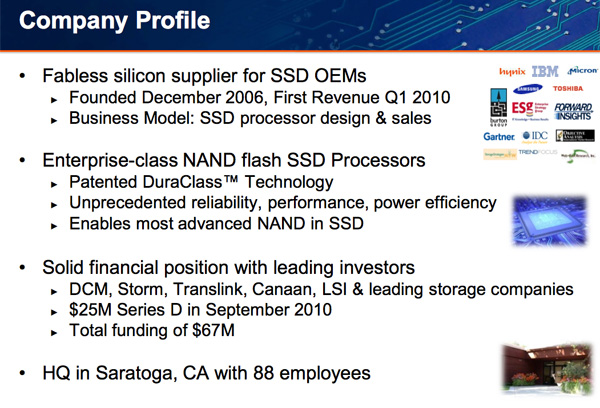SandForce Announces Next-Gen SSDs, SF-2000 Capable of 500MB/s and 60K IOPS
by Anand Lal Shimpi on October 7, 2010 9:30 AM ESTFinal Words
SandForce conveyed to me that although we may see hardware this year, production firmware and silicon won’t be ready until early Q1. Anything that ships before then is not what SandForce considers production worthy. This is an important distinction as SandForce’s partners often ship with pre-release hardware/firmware in order to gain traction and sales as quickly as possible. We’ll probably see less of this as SandForce matures as a company.
The specs behind the SF-2000 are downright amazing. If SandForce can deliver this sort of performance within two quarters I will be floored. If we’re talking about 500MB/s for a single drive next year, the sort of performance you’ll be able to get through a multi-drive array will be staggering. We’re easily heading towards gigabytes per second of affordable I/O bandwidth, not to mention that SandForce will have nearly maxed out 6Gbps SATA on its first attempt.
We will of course see drives from the usual suspects. OCZ, Corsair and even Seagate is now officially listed as a SandForce customer. Looks like those Pulsar rumors were true.
There’s still a long way to go before we’re at the point where we have a shipping SF-2xxx based drive with these specs however. If you remember the growing pains that Intel, Indilinx, Micron and SandForce all experienced with this current generation of controllers, I don’t expect the next round to be any easier.

SandForce is serious however. The company only has 88 employees but it just closed another round of funding ($25M Series D), bringing the total funding to $67M. The company is headed for an IPO. And if it can pull off the SF-2000 we saw on paper today, SandForce may have the sales to support it.










84 Comments
View All Comments
karndog - Thursday, October 7, 2010 - link
Put two of these babys in RAID0 for 1GB/s reads AND writes. Very nice IF it lives up to expectations!Silenus - Thursday, October 7, 2010 - link
Indeed. We will have to wait and see. Hopefully the numbers are not too optimistic. Hopefully there are not too many firmware pains. Still...it's an exciting time for SSD development. Beginning of next year is when I will be ready to buy an SSD for my desktop (have one in my laptop already). Should be nice new choices by then!Nihility - Thursday, October 7, 2010 - link
It'll be 1 GB/s only on non-compressed / non-random data.Still, very cool.
mailman65er - Thursday, October 7, 2010 - link
better yet, put that behind Nvelo's "Dataplex" software, and use it as a cache for your disk(s). Seems like a waste to use it as a storage drive, most bits sitting idle most of the time...vol7ron - Thursday, October 7, 2010 - link
"most bits sitting idle most of the time... "Thus, the extenuation life.
mailman65er - Thursday, October 7, 2010 - link
Thus, the extenuation life.Well yes, you could get infinite life out of it (or any other SSD) if you never actually used it...
The point is that if you are going to spend the $$'s for the SSD that uses this controller (I assume both NAND and controller will be spendy), then you want to actually "use" it, and get the max efficiency out of it. Using it as a storage drive means that most bits are sitting idle, using it as a cache drive keeps it working more. Get that Ferrari out of the barn and drive it!
mindless1 - Tuesday, October 19, 2010 - link
Actually no, the last thing you want to use a MLC flash SSD drive for is mere, constant write, caching.Havor - Friday, October 8, 2010 - link
I really don't get the obsession whit raid specially raid 0Its the IOPs that count for how fast your PC boots ore starts programs and whit 60k IOPs i think you're covert.
Putting these drives in R0 could actually for some data patterns slow them down as data is divided over 2 drives they have to arrive at the same time ore one of the drives have to wait for the other to catch up.
Yes you will see a huge boost in sequential reads/writs but whit small random data the benefit would negative, and the overall benefit would be around up to a 5% benefit. and the down side would be the higher risk of data loss if one of the drives breaks down.
mindless1 - Tuesday, October 19, 2010 - link
No it isn't. Typical PC boot and app loading is linear in nature, it's only benchmarks that try to do several things (IOPS) simultaneously, very limited apps or servers which need IOPS significantly more than random read/write performance.You are also incorrect about slowing them down waiting because if not the drives' DRAM cache, there is the system main memory cache, and on some raid controllers (mid to higher end discrete cards) there is even the *3rd* level of controller cache on the card.
Overall benefit 5%? LOL, if you are going to make up numbers at least try harder to get close or, get ready for it, actually try it as-in actually RAIDing two then run typical PC usage representative benchmarks.
Overall the benefit will depend highly on task, or to put it another way you probably don't need to speed up things that are already reasonably quick, rather to focus on the slowest or most demanding tasks on that "PC".
Golgatha - Thursday, October 7, 2010 - link
DO WANT!!!